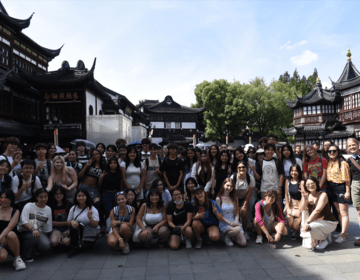Seeing Nanjing from atop a historical landmark

In 1929, the Nationalist Chinese government moved the body of revolutionary leader Sun Yat-sen to a lavish tomb on the Purple Mountain in Nanjing. 90 years later, a group of American students made the long trek through the woods and up the long set of steps to the summit, in cloudy but humid weather.
In the morning, students in level 1 learned about buying bubble tea and fruit. In level 2, the teacher explained how renting and buying apartments and houses works in China, and taught students words for rooms in the house and furniture. Level 3 students learned about beauty and aesthetic standards in China and how they compared to those in the United States.

After students went off on their own to find lunch, we met back at the school building and prepared to venture off. We took a comfortable, air-conditioned bus directly to 紫金山 (zǐ jīn shān), the Purple Mountain, where we walked along a wooded path to 中山陵 (zhōng shān líng), the final resting place of Sun Yat-sen. After a short history explanation from 季老师 (jì lǎo shī), our level 3 teacher, about Sun Yat-sen and his significance in history, we entered the complex. Students, sweating in the humid Nanjing summer air, were undaunted by the 392 steps to the top. Some quickly ran to the summit to take in the view, while others ascended more slowly.
Regardless, nearly all students made the journey to the top to take in the breathtaking view of the city. After stopping to take some photos and selfies, we went inside the tomb itself, to pass by the coffin of the famous Chinese revolutionary. Photos are not allowed inside, and students were told to be quiet and respectful as they passed through.

After descending the steps, we walked to a nearby open air amphitheater to take a break and play with the local white pigeons. Some students chased the pigeons around, others bought food to feed them, and still others just sat on the benches, taking in the scene. It had been a long, tiring day, but there was a sense of accomplishment and of appreciation for the beauty of the place we were visiting mixed in with the sweat and the desire to go home and rest.


Related Posts
Wuxi (无锡) - Day 2!
Hanfu (汉服) refers to the traditional clothes worn by the Han ethnic people of China. In ancient times, hanfu was distinguished by social status, occupation, and occasions. Those in the... keep reading

Exploring Shanghai - Visiting Yu Garden and Old City God Temple
On July 18, students visited the Yu Garden (豫园)and the Old City God Temple (城隍庙) in downtown Shanghai. During the excursion, students walked with their peers to explore the history... keep reading